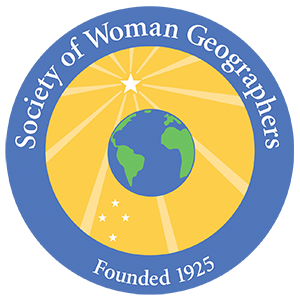

Elisabeth Telling (1882-1979) was a member of the Society of Woman Geographers from 1942 until her death in 1979, just three years short of her hundredth birthday. She loved to draw from the moment she could hold a pencil and attended children's Saturday classes at the Chicago Art Institute from the age of ten.
Her art studies were interrupted when she attended Smith College, because she found their art classes not worth taking. Upon graduation in 1904 she resumed her art studies in Chicago and later in Munich in 1914 with another Smith alumna. The two young women traveled around the countryside with their sketch books, inculcating the twin habits of sketching and traveling that Telling practiced the rest of her life. Their studies were cut short when World War I forced them to return home.
In 1922 Elizabeth entered a few small pencil portraits in the annual exhibition of Chicago artists at the Art Institute. To her surprise a stranger commissioned some portraits and thus launched her career as a portraitist. As her reputation rose, she continued to show her work in galleries across the country. In 1931 she traveled to Java and Bali, visiting important sites and delighting in the colorful clothing and festivals. In Bali she studied the costumes of the varied dances and recorded them in colorful drawings. Her affinity for ethnic portraiture had taken hold. These renderings were exhibited on her return in New York and Chicago earning her a solid reputation as an ethnographic artist. In 1933 the Field Museum sponsored her on a trip to the Yucatan, and in 1934 a four-month study of the indigenous Indians of Guatemala.
In an unpublished manuscript of her Latin American experiences, she describes the beauty of the landscape, discomfort of travel on rough roads, and trials of staying in rustic hotels and houses. The most difficult, however, was finding subjects willing to sit for her, as the local people were often hostile, suspicious, or unreliable. They didn't know quite what to make of portraits, but once the paintings were finished the sitters were quite pleased. She strove to represent the great variety of regional dress, range of colors, beauty of the woven cloth, and craftsmanship of the design.
In keeping with the times she accepted her position as a member of the educated class and, as such, was supported by other Americans and Europeans who knew the language and customs of the country. They offered her fine living spaces, good food, and bathrooms, all much appreciated. She learned neither the indigenous languages nor Spanish, so had to rely on interpreters who were not always easy to find. In spite of this barrier, she had great sympathy for the indigenous people, whom she portrayed with integrity and individuality, as shown in this exhibition.
